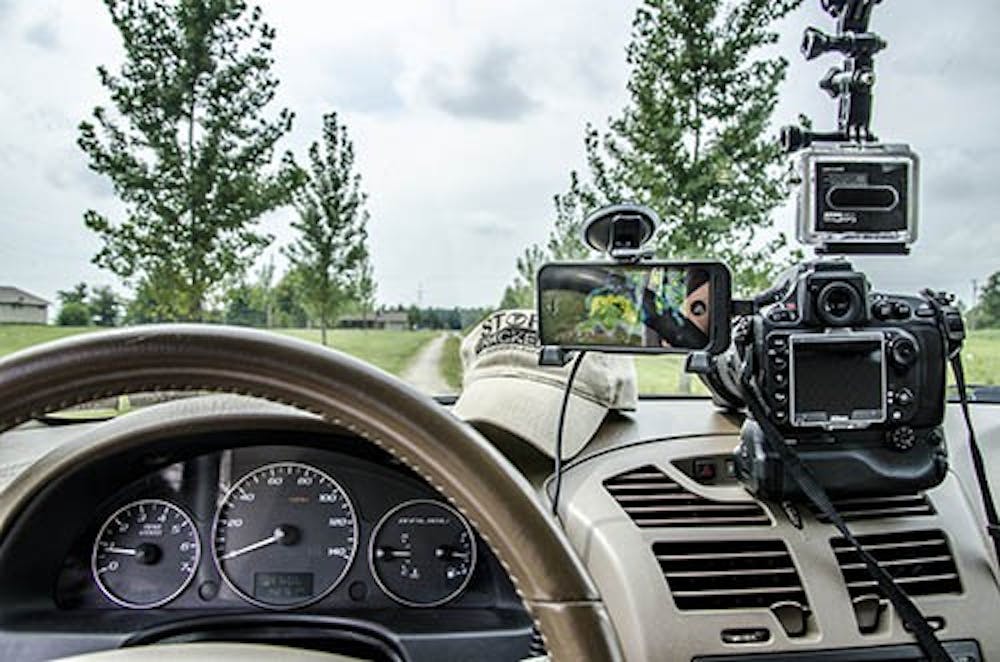The blue sparks of snapping electrical lines could be seen half a mile away, as Jason Berry watched a tornado tear through his town in Defiance, Ohio.
After the storm, the then 16-year-old Berry remembers walking outside to see wreckage raining from the sky.
“I remember debris falling and finding house insulation everywhere. I had never seen anything like that before,” Berry said. “I remember thinking, ‘This was someone’s house that was caught in the storm.’ I was holding a piece of someone’s home. That was an awe-inspiring experience.”
Since then, Berry has encountered nine tornadoes. However, now he chases them on their trail rather than watching them from indoors.
In 2008, six years after he saw his first tornado, Berry earned a degree in operational meteorology and climatology at Ball State and went on to be an on-air meteorologist for four years.
He worked at ABC News as a meteorologist in Bowling Green, Ky. and Erie, Pa.
“I had to study storms from in front of a camera and not get to actually go outside where they were,” Berry said. “I decided I wanted to go out and experience the storms and document them.”
He started his business, Storm Tracker WX, a year and a half ago. It’s an online site not only dedicated to tracking severe weather across the nation, but also to taking individuals in the path of the storm during tornado season.
Two weeks ago, Berry moved near Muncie to bring his business to Ball State students and give them a chance to get involved in storm chasing through his educational tour.
“For me, BSU is where it all started and I thought it would be a wonderful idea to offer this for students,” Berry said.
Next year, Berry will offer three tours including one 10-day tour in May and two ten-day tours in June. He uses an average-sized car as his mobile weather unit, not a heavy-duty van, for easy maneuverability and little wind resistance.
He tries not to attract attention to his vehicle in case rookie chasers might tail him while he is working. He said the growing popularity of storm chasing has created more traffic in the chase.
Assistant professor of geography David Call has taught a storm chasing class since 2008. Since he began teaching “Field Observations of Severe Local Storms,” attendance has gone from six students to 19 students in 2012.
“There’s been a lot of growth,” Call Said. “The interest for storm chasing has been going way up.”
Last year, Berry led his first tour in “Tornado Alley,” a line of Midwest states between the Rocky Mountains and Appalachian Mountains where tornadoes are known to wreak havoc.
Ten students from Pennsylvania State University traveled with Berry to seek storms across seven states.
While in Western Nebraska, the group encountered severe weather brewing right before sunset but had to abandon the chase because it is too dangerous to encounter a tornado at night.
“It lets an individual experience and see things they would normally never see,” Berry said.
The crew studied thunderstorm development and how tornadic storms form using Doppler radar, GPS systems, tools to measure things like wind speed and on scene observations. Berry said the National Weather Service depends on storm spotters.
“[Storm chasing] is significant to meteorology, because often meteorologists have to depend solely on Doppler,” Berry said. “If a storm with a tornado forms, chasers can provide information while on the field, and give real time information to let the public know sooner.”
Call said while much is known about tornados, the genesis of these phenomena is unknown.
“One of things in meteorologists are looking at is why some storms produce tornados and why others don’t,” Call said. “ We’re good at predicting when storm occur, but the stage at which intense become tornadic storms is still a question.”
It can be an unnerving experience and storm chasers catch their fair share of turbulence.
“It gets bad, where there are hail storms with hail the size of baseballs,” Berry said. “You’re driving in blinding rain while not knowing whether or not your windshield is going to hold up. It can be loud and frightening.”
This past May, three storm chasers were killed in El Reno, Okla., during a severe multivortex tornado. The men, members of TWISTEX, were part of a professional field research program featured on the Discovery Channel series “Storm Chasers.” According to the Storm Prediction Center, this was the first time scientists have been killed while chasing a storm.
Berry had worked with Tim Samaras, one of the chasers who was killed, on a few occasions and has a Samaras memorial ribbon on his storm chasing car.
“It’s really sad,” Berry said. “We try to learn from that and remember to experience these storms safely.”
Interested individuals can sign up at tours.stormtracker.wx.com, and sign up is open to the public.


